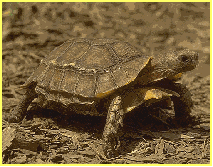
![]() Kinixys erosa (Schweigger 1812)
Kinixys erosa (Schweigger 1812)
A Captive breeding experience
Ashley Woods

General Description
Kinixys erosa, the largest of the "Hinge-backs" comes under a variety of common names: Eroded hinge-back, Serrated hingeback, Rosy hingeback and Schweigger hingeback.
This tortoise hails from West Africa and is a true rain forest inhabitant. The general colour is a rusty brown with pale yellow blotches to the supra marginal scutes. Males have pronounced gular forks and large thick tails.
Captive housing
Forethought must be given to their wild habitat while setting up a captive environment. These animals require a low light density, high humidity and a secure retreat.
My pair are housed in a vivarium, 110 cms x 60 cms x 60 cms. This is heated by a 120 watt tubular heater connected to a thermostat which is set to 28řC. This gives constant background warmth. Light is only provided by a nearby window, a retreat is supplied by a large hollow piece of cork bark, the tortoises spend much of their time in this.
A large water bath is provided in the form of a green house seed tray, this is half filled with water and changed almost daily. Newspaper is used as a substrate. A heavily planted outdoor pen is used during warmer summer months although the tortoises are brought in during the night.
Feeding
Kinixys erosa is omnivorous by nature, taking in the wild fallen fruits, leaves fungi, invertebrate and carrion. Captive diet includes mushrooms, various soft fruits and vegetables, for example: tomatoes, melon, blanched carrots, banana, pawpaw, cucumber and peaches.
Animal protein is provided every 2 - 3 weeks with whole dead mice and garden snails. Also, whilst in their outdoor enclosure browsing on weeds and grasses is observed. All indoor foods are supplemented by either Vionate or Nutrobal. Whole cuttlebone is available in the vivarium and it is well gnawed.
Courtship, mating and incubation
Mating activity is observed throughout the year. The male circling and ramming the female, sometimes turning her on her back. Mating is an energetic affair on behalf of the male with much hissing, very similar to Testudo hermanni.
Gravid activity in the female is much like other tortoises, with much pacing and reluctance to feed and, in the case of our female, spending much time in the water bath. During this time a shallow washing up bowl containing a mixture of damp sand and pat was placed in the vivarium. Steps made from small logs set up so the female could gain entrance to the bowl. After some four weeks of gravid behaviour five eggs were deposited in the bowl. These eggs were removed, washed and marked and placed in the incubator. They were half buried in damp vermiculite and the incubator temperature set at 30.5řC. (humidity running at 90%). Eggs upon laying were quite large considering the size of the female. Weight of eggs being 28 gms and measuring 45 mm x 40 mm.
Hatching and Juvenile Husbandry
At 130 days a crack appeared on one egg, this caused some concern. However after 7 days, the egg opened properly and out peered the first juvenile, this fully emerged after 140 days. The following two juveniles appeared at 154 days and 157 days, the remaining eggs being infertile.
The youngsters had extremely large egg sacs and for this reason were removed to a temporary nursery vivarium until the yolk sacs were completely absorbed . This temporary unit was kept at exactly the same temperature and humidity as the incubator, damp paper towels being used as a substrate to lessen any damage being done to the delicate yolk sacs.
After one week the young tortoises were removed to a more permanent unit a scaled down version of the adults vivarium ,with the exception of having bark chippings as a substrate, these giving a more natural effect and can be sprayed with water, helping to keep humidity high. The only draw back I find is that bark chippings are difficult to keep clean particularly with larger tortoises.
The juveniles are very active indeed during early morning, but retreat to their log during the afternoon and night. Various foods have been offered, the following being preferred at the moment, banana, peach, cucumber (grated), pear, mushroom, lance fish and chopped earthworm. Again the sane supplements as the adults are sprinkled to every meal.
The juveniles are similar in colouration to the adult tortoises, but lack the characteristic hinge and have a very spiny carapace edge. Hatchling weights varied, the lightest being 17 gms , the heaviest being 22 gms. All measuring 45 mm x 45 mm.